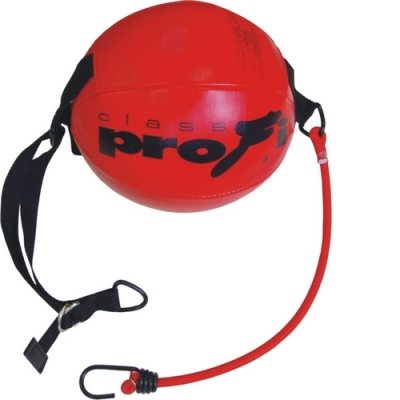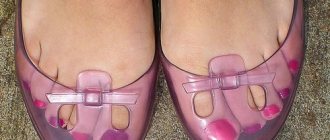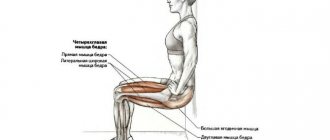A pear figure can be recognized by its wide hips with a narrow waist and small breasts. Even thin pears have hips and legs that seem heavy. It is the “pears” who are more susceptible to cellulite than others, and it is most difficult for them to lose weight in the hips. But the right workout for losing weight in your legs will help you get rid of extra pounds in the hips and buttocks.
We offer you a ready-made, effective 3-day program for “pears” without equipment, aimed at working on problem areas, fat burning and weight loss.
- Day 1: Intense Cardio for Leg Slimming (Monday)
- Day 2: Leg slimming workout without jumping (Wednesday)
- Day 3: Low Impact Workout for Slim Legs on the Floor (Friday)
Day 1 (intense cardio to lose weight in legs)
In pears, extra pounds are deposited in the hips, and in order for them to go away, you will have to do active cardio. Intense cardio training stimulates metabolism and promotes weight loss. In our leg slimming workout you will find intense functional exercises that are performed in a cardio mode for maximum results.
The first day included the following exercises:
- Jump squats with rotation: 10 reps on each side (20 squats total).
- Forward swings: 15 swings on each side (30 swings in total).
- Jumping lunges: 10 lunges on each side (20 lunges total).
- Steps in a half squat with raising your toes: 5 passes on each side (10 passes in total).
- Sprint: 30 reps on each side (60 hops total).
- Side and diagonal lunges (right leg): 10 side + 10 diagonal lunges (20 lunges total)
- Side and diagonal lunges (left leg): 10 side lunges + 10 diagonal lunges (20 lunges total)
- Double jump squats: 10 reps (20 squats total).
- Scissors with arm raises: 25 reps on each side (50 jumps total).
- Knee to stomach with back lunge (right leg): 15 reps.
- Knee to stomach with back lunge (left leg): 15 reps.
- Lateral jumps touching the floor: 10 touches on each side (20 squats in total).
The number of repetitions is approximate, you can adapt the load to your capabilities.
Jump squats with rotation
How to do it: Place your feet slightly wider than your shoulders and do a wide squat. As you rise, jump up, turning your pelvis to the left. Squat down again and jump to the right. Perform the exercise at a dynamic pace to burn fat.
How to make it easier: As part of your workout to lose weight on your legs, perform regular jump squats without turning at a moderate pace. If jumping is contraindicated, just squat and instead of turning, rise on your toes.
How much to do: 10 reps on each side (20 squats total).
Swing forward
How to do it: From a standing position, with your feet shoulder-width apart, alternately lift each leg out to the sides forward, trying to touch the toe of the opposite palm. You should not bend your knees, keep them tense and stretch them as much as possible, trying to lift them as high as possible.
How to make it easier: Bend your knees as you lift your leg up.
How much to do: 15 swings on each side (30 swings in total).
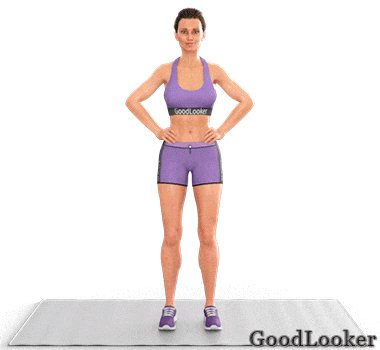
Jumping Lunges
How to do it: Place your feet together and lunge forward, jumping rather than walking. Then return to the starting position and repeat with the other leg. Perform rhythmic jumping lunges, not forgetting about technique: keep your knees bent at right angles and keep your back straight.
How to make it easier: To make your leg slimming workout a little easier, jump in place between lunges 4 times instead of 1 time. For the easiest version, perform classic forward lunges without jumping.
How much to do: 10 lunges on each side (20 lunges in total).
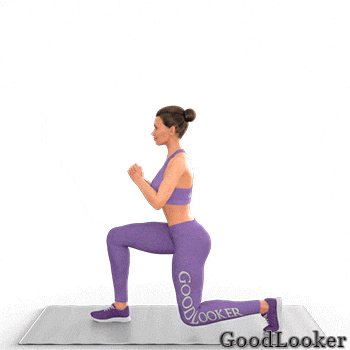
Half squat steps with toe raises
How to do it: Stand in a half-squat, feet shoulder-width apart, arms in front of you. Then take three rhythmic side steps. At the extreme points, lift your toes twice.
How to make it easier: At the end of the movement, do not perform a calf raise, but if it is still difficult, then do not three steps, but two.
How much to do: 5 passes on each side (10 passes in total).
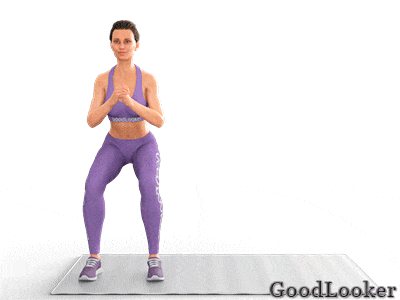
Sprint
How to do it: Bend your knees slightly and place your hands in front of you, as if running. From this position, run fast and rhythmically in place at the highest possible pace.
How to simplify: If this exercise from the training for “bags” seemed too difficult, then simply slow down and run at a moderate pace. If running is contraindicated, walk quickly.
How much to do: 30 reps on each side (60 jumping jacks total).

Lunges to the side and diagonally
How to do it: Stand with your feet shoulder-width apart and keep your hands in front of you. Do a classic lunge to the side with your pelvis pulled back. Coming back, lunge back diagonally, and then lunge to the side again, and so on in a circle. Perform a whole set on one leg, then the next set on the other leg.
How to make it easier: Lunge to the side and return to the starting position (in a normal stance), and only then lunge back diagonally.
How much to do: 10 side lunges + 10 diagonal lunges (total 20 lunges on one leg), then the same amount on the other leg.
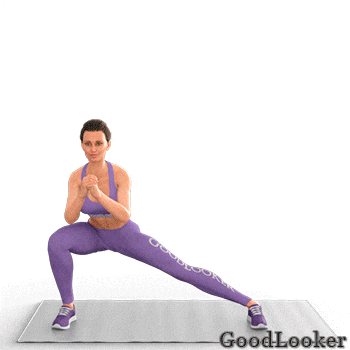
Double jump squats
How to do it: Stand in a wide stance and first do a classic squat, and then a jump squat. When squats, move your pelvis back and try to jump as high as possible.
How to simplify: If the exercise from the workout for losing weight on the legs seems very difficult, then perform jump squats every two squats (squat-squat-jump squat). If this option is also difficult, then you can do ordinary squats without jumping at a fast pace.
How long to do: 10 reps (20 squats total).
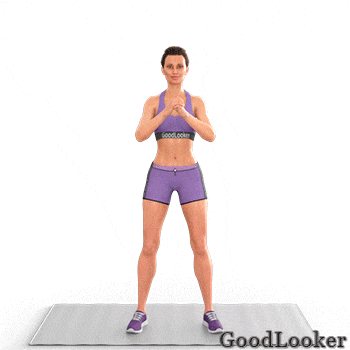
Scissors with hand raise
How to do it: Stand up straight and jump not up and down, but back and forth, alternately moving each leg, as if walking. At the same time, raise and lower each arm in turn, synchronously with the movements of your legs.
How to simplify: During the exercise, do not use your arms, only do jumping to slightly reduce the load. You can put your hands on your belt.
How much to do: 25 repetitions on each side (50 jumps in total).
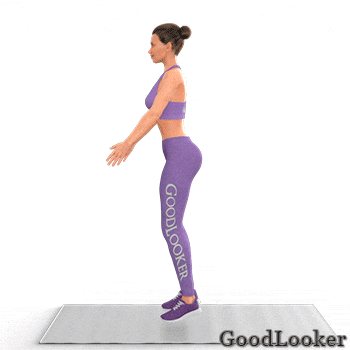
Knee to stomach with back lunge
How to do it: Shift your body weight to your right leg and pull your left knee toward your stomach. Then do not return to the starting position, but immediately lunge back with your left leg. As you lunge, bend down and touch your left hand to your right foot. Perform a whole set on one side, then the next set on the other side.
How to make it easier: Raise your knee, then lower your leg to the floor, returning to your normal stance. And only then lunge from a stable position.
How much to do: 15 repetitions first on one side, then 15 repetitions on the other side.
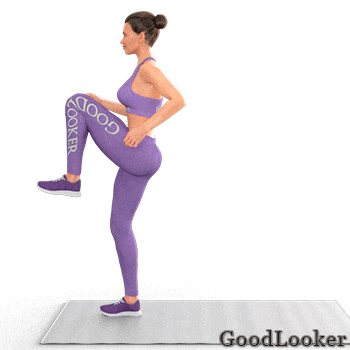
Side jumps touching the floor
How to do it: Stand in a wide stance and bend your knees slightly, lowering yourself into a half-squat. Now perform side jumps, trying to touch the floor with your hand on each one or at least reach the level of your feet or ankles.
How to make it easier: To make your thigh-slimming workout a little easier, you can do lateral jumps without touching the floor.
How much to do: 10 touches on each side (20 squats in total).
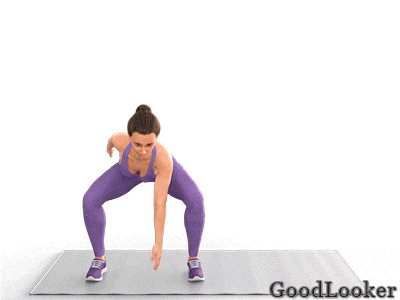
Experienced practitioners can repeat the exercises in 2-3 circles.
Problem areas for girls with an hourglass figure
Girls with an hourglass figure can boast of a normal rate of loss of fat mass and gain of muscle mass, but at the same time they also have their own disadvantages, which manifest themselves in problem areas:

When the “sandy” beauty gets better, first of all she gets better in the hips, and the nasty “pop ears” immediately appear. I made more than one video about how to get rid of “ears on the thighs” and even wrote an article on this topic “How to remove fat from the thighs? A training program that gets rid of “butt ears.” You can familiarize yourself with them if you wish.
Also among the disadvantages of the sand type of figure is that as soon as the girl gets better, she very quickly loses her former triceps muscle tone, which begins to sag a little. Summer is approaching right now, and if the “daddy’s ears” can be hidden under a long light skirt, then the arms are almost always in plain sight, and a girl’s saggy triceps are not such an attractive picture, as for me...
- How to get rid of fat on your arms? TOP 5 triceps exercises
Even these girls almost instantly get better breasts, but I would most likely attribute this feature to the advantages of our body type rather than to disadvantages (at least some positive aspect in all this disgrace).
The waist practically does not suffer, and in general the main advantage of this type of figure is, without a doubt, a narrow waist. Its ratio is approximately 70-75% of the hip circumference. When a girl gains extra pounds, her waist certainly becomes larger in centimeters, but visually, compared to her hips and chest, she remains just as thin and graceful, which makes such girls sexier compared to other body types (apple and rectangle).

In order to correctly create a weight loss training program for girls with an hourglass figure, you need to take into account all of the above features and pay sufficient attention to problem areas, placing the emphasis correctly.
Day 2 (weight loss workout without jumping)
To effectively lose weight, you need to keep your heart rate in the cardio zone during exercise. This can be done without jumping or running if you perform compound exercises at an intense pace. The second day of our thigh slimming program does not involve jumping, but provides an effective cardio load through multi-component functional exercises, which will help you significantly slim your thighs.
The second day included the following exercises:
- Squats with diagonal lunges: 10 lunges on each side (20 squats total).
- Side kick (right leg): 20 kicks.
- Side kick (left leg): 20 kicks.
- Spring steps from a half squat: 15 leg abductions on each side (30 leg abductions in total).
- Plank to squat raise: 10 raises from each leg (20 squat raises in total).
- Squat with shin overlap: 15 touches on each side (30 squats in total).
- Side swings: 15 swings on each side (30 swings in total).
- Back Lunge with Leg Swing (right leg): 15 reps.
- Back lunge with leg swing (left leg): 15 reps.
- Narrow squats with rotation: 10 leg abductions on each side (20 squats total).
- Low Impact Skater: 15 touches on each side (30 half lunges total).
- Knee tuck: 20 reps.
The number of repetitions is approximate, you can adapt the load to your capabilities.
Squats with diagonal lunges
How to do it: Stand in a wide stance and perform a squat, moving your pelvis back without bending your back. As you come up from the squat, take a step back and to the side, lowering into a diagonal lunge. Come back and on your next squat rise, lunge diagonally with your other leg.
How to simplify: In order to make this leg weight loss exercise easier, you can slow down the pace or avoid going into a deep squat.
How much to do: 10 lunges on each side (20 squats total).
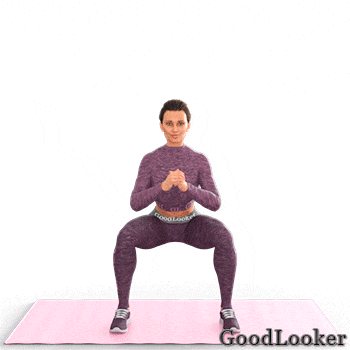
Kick to the side
How to do it: Stand in a boxing stance, clench your hands into fists in front of you and bend your legs slightly. Then perform vigorous kicks to the side, as if punching a punching bag. At the same time, move your body back and lift your leg along the trajectory up and to the side. Perform a whole set on one side, then the next set on the other side.
How to simplify: Perform leg swings with a small amplitude, do not lift your leg high.
How much to do: 20 kicks on one side, then 20 kicks on the other side.
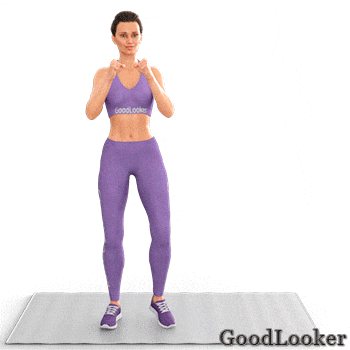
Springy steps from a half-squat
How to do it: Bend your knees slightly, lowering yourself into a half-squat. From this position, move your leg to the side, making pulsating movements up and down, and return back. Don't slouch, tighten your buttocks and move your pelvis back.
How to make it easier: Straighten up after every two leg abductions to relax the muscles a little.
How much to do: 15 leg abductions on each side (30 leg abductions in total).
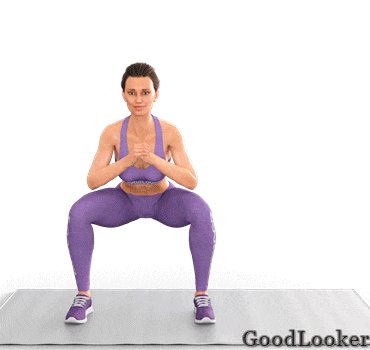
Raise from plank to squat
How to do it: Get into a plank position with your arms straight, and then take two steps forward so that your feet are slightly behind your shoulders. Now raise your body into a classic squat. When lifting, do not change the position of your hands so that it is convenient to return to the plank. Don't forget to alternate repetitions in one approach, i.e. First, the right leg steps out of the plank first, then the left leg.
How to simplify: If an exercise from a workout for a pear body type turns out to be difficult, then try doing it slowly or not completely. The latter means that you do not need to rise into a squat. It is enough to take two steps forward and two steps back from the plank to return to the starting position.
How much to do: 10 lifts from each leg (20 squat raises in total).
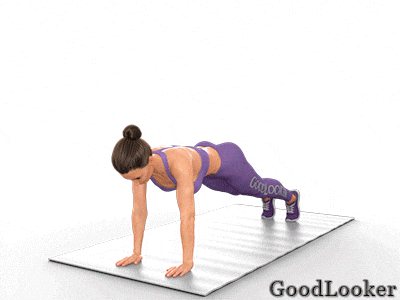
Squat with shin overlap
How to do it: Stand in a wide stance and perform a sumo squat. Then, as you rise, cross your shin with your right leg and lower back into a squat. On the next lift, do a shin sweep with your left leg. Perform the exercise at a rhythmic pace.
How to make it easier: To make this thigh-slimming exercise easier, do it at a slow pace and don't squat deeply.
How much to do: 15 touches on each side (30 squats in total).
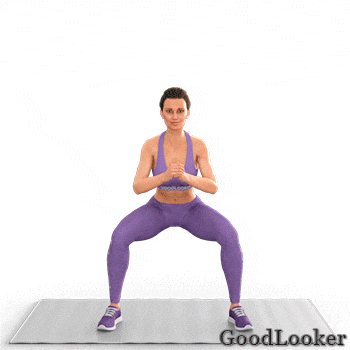
Swing to the sides
How to do it: Stand straight with your arms in front of you. Alternately lift each leg to the side until it is parallel to the floor. At the same time, the body remains stable. The leg should move in one plane along a trajectory from bottom to top and back.
How to simplify: If you cannot achieve parallelism with the floor, then raise your leg to your maximum height. You can also perform swings not with each leg in turn, but first do all the swings with one leg, and then with the other.
How much to do: 15 swings on each side (30 swings in total).
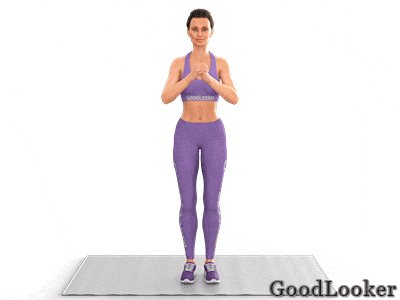
Back lunges with leg swing
How to do it: From a standing position, with your feet shoulder-width apart, lunge back. Then, without returning to the starting position, kick forward with the same leg, trying to reach the opposite palm with your leg. Perform a whole set on one side, then the next set on the other side.
How to Simplify: To make your thigh-slimming workout a little easier, break the compound exercise into two: back lunges and forward kicks. To do this, after performing a backward lunge, return to the starting position (i.e. place your working leg next to the supporting leg), and only then perform a forward kick.
How much to do: 15 reps on one leg, then 15 reps on the other leg.
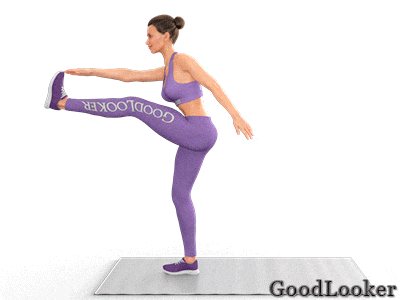
Narrow squats with rotation
How to do it: Place your feet together and do a classic squat in a narrow position. At the bottom point, move your leg to the side to the left, turning your whole body after it. Come back up from the squat. On your next squat, rotate to the right.
How to simplify: To make the exercise easier, squat not to parallel with the floor and gradually increase the load.
How much to do: 10 leg abductions on each side (20 squats in total).
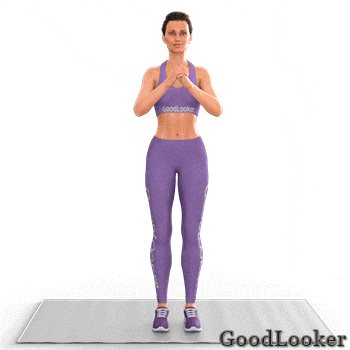
Low impact speed skater
How to do it: From a standing position, perform a half-lunge back diagonally, while trying to reach the foot of your front leg with the opposite hand. Perform lunges alternately with each leg at a medium pace.
How to make it easier: Perform regular diagonal half-lunges without touching your foot with your hand. This way you will reduce the load a little if the exercise from the training for “pears” turned out to be difficult for you.
How much to do: 15 touches on each side (30 half-lunges in total).
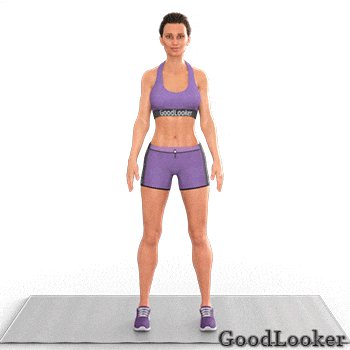
Reduction of the knees
How to do it: Place your feet wider than your shoulders and lower yourself into a deep half-squat, keep your arms in front of you, and lean your body forward slightly. Now bring your knees together until they touch each other, and then spread them as wide as possible. Try not to straighten out of the squat or bend your back.
How to simplify: Reduce the range of motion; to do this, do not bring your knees together too much. To make it easier, you can also avoid squatting too low.
How much to do: 20 repetitions.
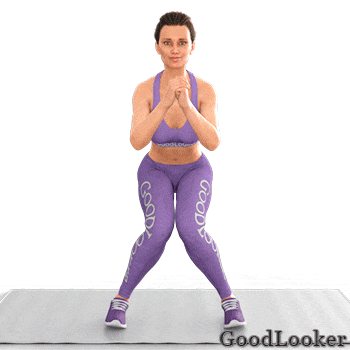
Experienced practitioners can repeat the exercises in 2-3 circles.
How to train as a pear and achieve nothing
Let's start, as usual, with the bad advice that sports and other public pages are filled with. Usually we are advised:
- do cardio, and only that. Give up on the gym, because all these heavy things grow terrible muscles;
- exercise, for example, for 30-40 minutes on a treadmill, stepper, elliptical trainer, then swing your legs back and sideways for 20 minutes without weights, and “don’t forget about the top,” performing 1-2 indistinct series of swings with your arms to the sides with dumbbell weights 2 kg. Preferably pink.
- don’t go anywhere at all except for Pilates and yoga classes. Allegedly, only muscles do not grow from them, but from everything else they do.
Why doesn't all this work? Yes, because the problem does not stem from “muscle growth”, but from... too much fat, lack of tone of these same muscles, and unbalanced development of the “top” and “bottom” of the body. I’m not going to write here about obvious things, like sweets for breakfast, sandwiches for lunch, and a pan of fried potatoes for dinner.
If you follow the first strategy, you will get... a smaller copy of yourself, that is, thinner, but still too voluminous hips and buttocks, and string-like arms, a stooped back, and, if you're lucky, abs pumped up by endless crunches. You already have no problems with your stomach, but your legs, against the backdrop of all this splendor, will look “like they came from another aunt.”
If you follow the second strategy, you, at best, will again get a smaller copy of yourself. If you are on a low-calorie diet, from the word “absolutely”. If you don’t, miracles won’t happen in nature either; if you lose a little weight, you will “stagnate.” Usually, independent exercise on cardio equipment suffers from a lack of intensity. Yes, you will increase your endurance a little and strengthen your cardiovascular system, but nothing more.
In the third option, everything greatly depends on the style of yoga practiced and the diet followed. If yoga is Ashtanga Vinyasa, and the diet, for example, is “for need” and not “for deficiency”... get ready for terrible muscles. They will definitely appear on the arms, abs and back. If you don’t miss classes and start practicing every day for 1.5 hours as Sri Pattabhi Jois bequeathed.
[back to contents]
Day 3 (low impact workout for lean legs)
Low-impact workout for the pear body type is designed to create beautiful leg contours. With its help, you can make the outlines of your hips clearer, lift your buttocks, make your legs slimmer, without weakening your quadriceps. Also, the benefit of the training is that it does not load the joints, acting exclusively on the muscles, which allows you to target problem areas in a gentle manner.
The third day included the following exercises:
- Swing your leg up and diagonally: 20 repetitions, first on one leg, then 20 repetitions on the other leg.
- Fire hydrant leg extension: 20 reps first on one leg, then 20 reps on the other leg.
- Circular rotations with the leg: 10 rotations in one direction and 10 rotations in the other direction, then the same on the other leg.
- Pulsating lateral swings: 25 pulses first on one leg, then 25 pulses on the other leg.
- Pulse Plank Swings: 10 reps first on one leg, then 10 reps on the other leg.
- Swings from a half-sitting position: 25 repetitions, first on one leg, then 25 repetitions on the other leg.
- Kicks from a half-sitting position: 15 repetitions, first on one leg, then 15 repetitions on the other leg.
- Side plank kicks on your knees: 20 reps first on one leg, then 20 reps on the other leg.
- Circular rotations from a side plank on your knees: 10 rotations in one direction and 10 rotations in the other direction, then the same on the other leg.
- Wide scissors: 15 repetitions on each single leg (30 lifts in total).
- Synchronized circular rotations with legs: 15 rotations in one direction and 15 rotations in the other direction.
- Scissors: 20 reps on each single leg (40 lifts total).
The number of repetitions is approximate, you can adapt the load to your capabilities.
Swing your leg up and diagonally
How to do it: Get on all fours and straighten your left leg. Then lift it up and lower it diagonally to the right, trying to get it behind your supporting leg. Raise your leg up again and return to the starting position.
How to make it easier: Perform diagonal swings without bringing your legs to the starting position. To do this, simply lift your leg up and move it diagonally, then lift it again and lower it along the same path.
How much to do: 20 repetitions first on one leg, then 20 repetitions on the other leg.
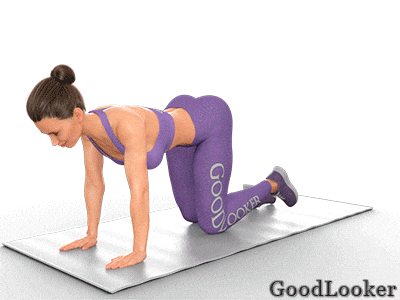
Fire hydrant with leg extension
How to do it: While remaining on all fours, swing your leg bent at the knee to the side. Then straighten your leg while suspended, bend it again and return back.
How to simplify: To make the leg weight loss exercise easier, perform the fire hydrant in the classic version without straightening your legs. To do this, simply swing your leg bent to the side.
How much to do: 20 repetitions first on one leg, then 20 repetitions on the other leg.
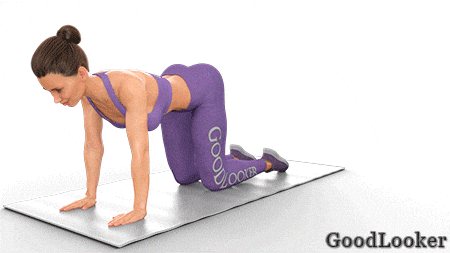
Circular rotations with the leg
How to do it: Lie on your side and lift one leg up at a 45-degree angle. Perform circular rotations with your leg with full amplitude clockwise: forward-up-back-forward again. Then rotate counterclockwise.
How to make it easier: Perform classic leg swings while lying on your side. The main thing is to maintain an angle of no more than 45 degrees so that the load on the hips is maximum. At the lowest point, do not touch the floor with your foot, as the muscles will be in constant tension.
How much to perform: 10 rotations in one direction and 10 rotations in the other direction, then the same on the other leg.
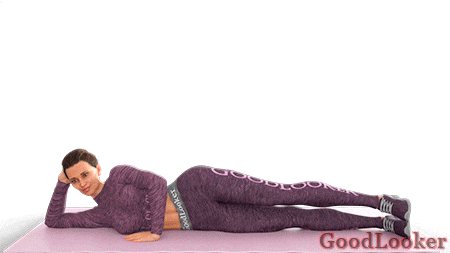
Pulsating side swings
How to do it: Without changing position, raise your leg 45 degrees and perform light pulsating movements with your leg up and down with a small amplitude. Try to keep your leg tense so as not to reduce the load.
How to make it easier: Increase the range of motion slightly if pulsing is difficult.
How much to do: 25 pulsations first on one leg, then 25 pulsations on the other leg.
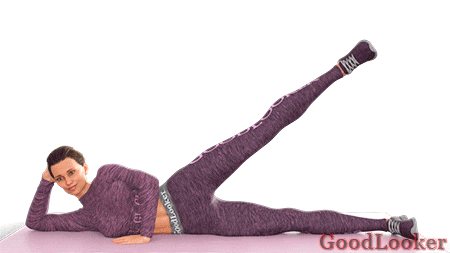
Plank swings with pulsation
How to do it: Stand in a plank position with straight arms, stomach tucked, back straight, pelvis not going up. Now lift one leg and perform a 1-2-3 pulse at the top point. Tighten your glutes and core as you perform. Advanced people may not touch the floor with their foot when lowering their leg.
How to simplify: Since this exercise from the workout for the pear body type is quite complex, it can be made simpler. To do this, perform regular swings without pulsation - touching the floor with your toes at the end of the movement.
How much to do: 10 repetitions first on one leg, then 10 repetitions on the other leg.
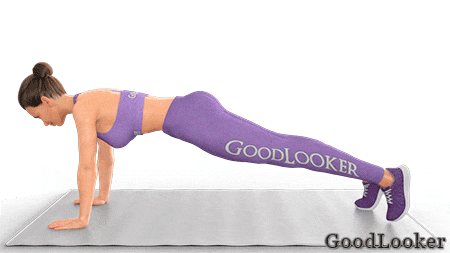
Swings from a half-sitting position
How to do it: Sit on the floor and lean on your right forearm. Bend your left leg at the knee and vigorously lift your right leg up, performing swings with a medium amplitude. At the bottom point, do not touch the floor with your foot to keep your leg constantly tense.
How to simplify: Since it will be difficult to keep your leg constantly suspended, you can perform swings with full amplitude - touching the floor at the bottom point of the movement.
How much to do: 25 repetitions first on one leg, then 25 repetitions on the other leg.
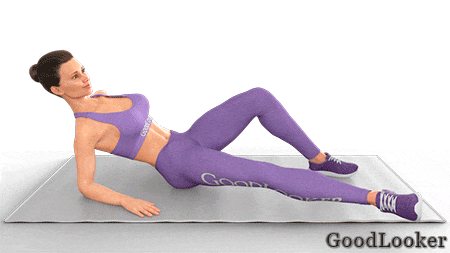
Kicks from a half-sitting position
How to do it: Without changing position, bend your right leg at the knee, and then straighten it forward and to the side without returning to the starting position. The leg should be constantly suspended so that the load on the hips is maximum.
How to simplify: Straighten your leg only to the side or only forward if the full version of the exercise seems difficult to perform.
How much to do: 15 repetitions first on one leg, then 15 repetitions on the other leg.
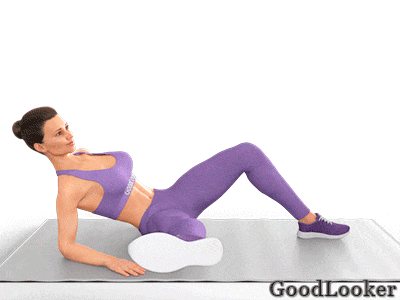
Kick kick from a side plank on your knees
How to do it: Get into a side plank position using your left arm, then lower your left knee to the floor. Bend your right leg at the knee so that in the initial position it lies on top of your left. Now lift your right leg and straighten it as if you are trying to hit a wall, and then return back.
How to make it easier: To perform the exercise from the workout for slimming your thighs in a lighter version, simply lift your leg bent at the knee and straighten it, holding it on weight, for a given number of repetitions.
How much to do: 20 repetitions first on one leg, then 20 repetitions on the other leg.
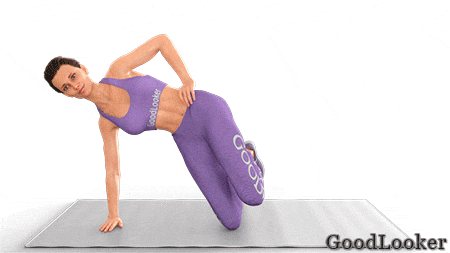
Circular rotations from a side plank on your knees
How to do it: Stay in the side plank, only now straighten your leg and perform circular rotations with a small amplitude. Remember to repeat clockwise and counterclockwise.
How to simplify: If it is difficult to perform rotations, then do classic swings. To do this, simply rhythmically lift your leg up at an acute angle.
How much to perform: 10 rotations in one direction and 10 rotations in the other direction, then the same on the other leg.
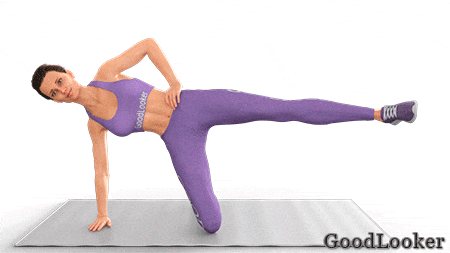
Wide scissors
How to do it: Lie on your back and lift your legs straight up. Now spread them as far apart as possible, and then bring them back, performing classic scissors with each leg in turn.
How to simplify: Reduce the amplitude of the fly, which will help reduce the load and make the exercise easier. You can place your hands under your buttocks, this will make it more convenient to hold the position.
How much to do: 15 repetitions on each leg (30 flyes in total).
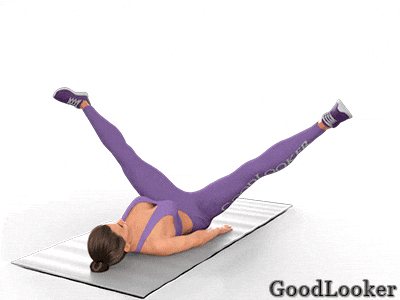
Synchronized leg circles
How to do it: Without changing position, extend your legs up and perform circular rotations with each leg towards each other. First, move your legs towards the body, and then spread them and bring them together again at the end point of the movement.
How to simplify: If you can’t do the exercise from the training for “pears”, then try to make it easier, for example, do circular rotations in turn - first with one leg and then with the other.
How much to perform: 15 rotations in one direction and 15 rotations in the other direction.
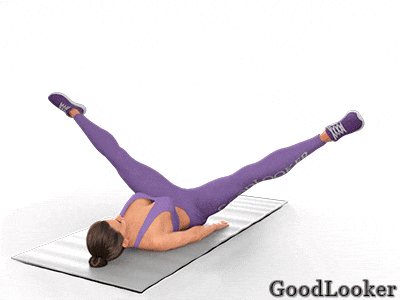
Scissors
How to do it: Staying on your back, lift your legs straight up. Now do classic scissors, alternately crossing your legs with a small amplitude. When performing the exercise, you should not rush, so as not to reduce the load on the working muscles.
How to simplify: If scissoring is difficult to do, you can slightly bend your knees, this will relieve tension from the muscles.
How much to do: 20 repetitions on each leg (40 flyes in total).
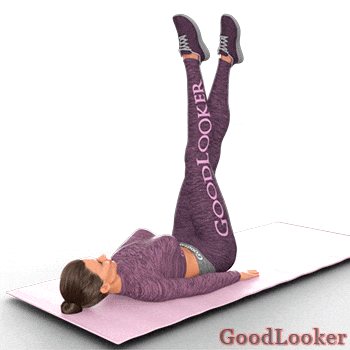
Experienced practitioners can repeat the exercises in 2 circles.
How to do timed workouts:
- For the first and second days (entry level). Exercise scheme: 30 seconds of work, 30 seconds of rest. You can repeat the exercises in 2-3 circles. Ready timer 30 seconds work / 30 seconds rest.
- For the first and second days (advanced level). Exercise scheme: 30 seconds of work, 15 seconds of rest or 40 seconds of work, 20 seconds of rest. You can repeat the exercises in 2-3 circles. Ready timer 30 sec / 15 sec and ready timer 40 sec / 20 sec.
- For the third day. Exercise scheme: 45 seconds of work, 15 seconds of rest or 40 seconds of work, 20 seconds of rest. Ready timer 45 sec / 15 sec and Ready timer 40 sec / 20 sec.
To train using a timer, you can download the Tabata Timer mobile application, which allows you to set timers for training yourself. See also our selection of mobile phone apps with timers for training. In addition, the links above offer videos with ready-made timers that are convenient to practice with.
Training “for pears” depending on sports orientation
[back to contents]
Classic fitness strength or physical training in the gym
Goal: to balance the figure, but not to reach the shape of performing athletes. That is, get something like Vera Brezhneva or Nadezhda Granovskaya in the end.
Means: 3 strength training sessions per week for the “whole body”, 2 exercises for each large group, except the notorious legs. “On your feet” - one basic (squat or deadlift) in a multi-repetition mode. The squat is periodically changed to a lunge, a Bulgarian split squat or a 1-leg squat, in especially good cases. Everything except the legs “swings” in the classic fitness mode - 10-12 repetitions, 3-4 approaches, 60 seconds pause between approaches. “Legs” depend on the coaching vision. Some even give tabata for them. Well, so what, no one has “swinged” with her yet. Supplemented with cardio in exercise machines, as feasible. That is, interval is rarely given, and only to advanced ones.
Tip: You have to follow a diet. Otherwise, it’s not that your legs will grow, but rather that your fat won’t be burned.
Cons: Dull, does not allow you to get into good athletic shape if you continue to work in this mode all your life. Slightly improves strength indicators and speed qualities. In short, for aesthetics, not for life.
[back to contents]
Strength functional fitness
Target: Have you seen Camille Le Blanc-Bazinet? Yes, we saw, all the public places around the sports are filled with her photos. In general, the goal is to achieve good physical fitness, which usually comes with pleasant side effects like decreased body fat and increased muscle mass.
Means: Strength functional training of mixed format. Typically, you will be doing squats and deadlifts on your feet. But with average weight and in a fairly high-repetition mode. “For everything else,” you will do pull-ups, push-ups, and jerks and push-ups. Stop, they are also on their feet. It turns out that this strength and functional fitness is not suitable for pears? Suitable because there are almost no hypertrophy modes of work, and you have enough testosterone to make hypertrophy “happen like crazy.” Stuffing the top and back occurs mainly through a combination of different types of exercises.
The trick: in general, SFF is not aimed at those who work on problem areas, etc. But among sports “Fat Burners” it is really the best, because it allows you to burn the most energy, and really works for the balanced development of the muscular system.
Cons: only for those who really want to train and are willing to devote at least an hour 4 times a week to training, and not simulating it. This is usually quite difficult, but doable for most healthy people
[back to contents]
Making a training plan
You need to decide what type of punching bag you will use and then create a training plan. I want to offer you a training plan that is suitable for training with a classic bag, a sack bag and a drop bag .
The program will be aimed mostly at practicing punches and increasing endurance while delivering them.

IMPORTANT! Don't forget to purchase boxing gloves along with the punching bag. Perhaps bloody hands look courageous, and you can tell the girl something about where and how you received “battle wounds”, but in other cases, it is better to do without extreme sports.
And there is no need to bandage your hands; now there are bandage gloves on sale that are designed specifically for boxing. Put them on, put gloves on top and... into battle!

Workout for a pear-shaped figure
It is designed to give more definition to the arms and shoulders. Your figure will look more serious this summer. There is no point in going to the gym and getting acquainted with fancy equipment there. All you need is a gymnastics ball and a bench, as well as the desire to change.
Sports nutrition – L-carnitine, fat burners – will help speed up the fat burning process. These supplements are specially designed for athletes and fitness-active people of different fitness levels. Such drugs are completely safe, and their effectiveness has already been proven.
What are the types of punching bags?
The results of your training directly depend on the training plan you choose. And in order to draw up a plan correctly, you need to decide on the type of punching bag , since the technique of striking depends on this.
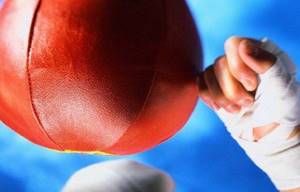
So, punching bags can be in the form of:
- Punching bag
- Punching bag on stretch marks
- Drop pears
- Boxing mannequin
- Pneumatic bulb.
